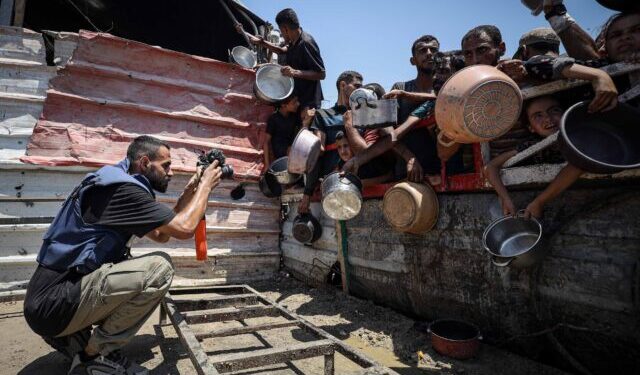A revealing new investigation by Germany’s Bild newspaper has pulled back the curtain on how Gaza’s so-called “hunger crisis” is being strategically framed for maximum Western outrage — and the manipulation is more calculated than many in the media care to admit.
According to the report, one particular freelance photographer, Anas Zayed Fteiha, has become a central figure in shaping international perception. He works for Anadolu, a Turkish state-run news agency, and has reportedly staged photo ops to dramatize suffering — selectively emphasizing women and children while deliberately avoiding scenes that show Palestinians actually receiving food aid.
In one widely circulated image, Fteiha is shown capturing a dramatic shot of desperation: Palestinians reaching toward a food truck. But other photographers on scene captured the full picture — and it didn’t match the narrative. The reality? Mostly adult men calmly receiving food, not the frantic scene of starvation that Fteiha’s composition implied.
Why the manipulation?
Well, it may not be purely journalistic ambition. Fteiha’s own Instagram features a dramatic image of himself in combat gear with the words “Free Palestine” emblazoned over a stylized, militant backdrop. The artist who created it, according to Bild, is an openly avowed anti-Semite. This is not objective journalism — it’s propaganda, dressed up as photojournalism, disseminated through respected international agencies.
As Bild notes, the hunger is real, but the imagery is orchestrated — filtered through a lens intended to provoke maximum outrage toward Israel, while conveniently omitting context or complexity.
And this isn’t an isolated incident.
Photography experts and historians are sounding the alarm. Gerhard Paul, a professor cited by Süddeutsche Zeitung, stated bluntly: “In southern Gaza, Hamas controls 100 percent of image production.” That means virtually every photo coming out of the region is subject to Hamas oversight — or worse, active staging.
The goal is clear: manufacture global sympathy for Hamas by emotionally manipulating Western media consumers.
The Israeli Foreign Ministry shared Bild’s findings, emphasizing that Hamas uses carefully staged images, funneled through partisan freelancers and sympathetic news agencies, to warp global opinion. These aren’t just pictures — they’re psychological weapons in an information war.
Journalist Avi Mayer highlighted the stark double standard in media coverage. Photos of allegedly “starving” Palestinian children — who were later shown to be suffering from unrelated medical conditions — made front pages worldwide. But when real evidence surfaced of Israeli hostages deliberately starved by Hamas in captivity? Crickets.
Mayer notes that outside of the New York Post, only four other newspapers covered those images — and they were all Israeli outlets. The same global press corps that amplifies manipulated Gaza imagery without question suddenly turns silent when the victims are Jews held hostage.
What we’re seeing is a chilling breakdown in media integrity — not just selective coverage, but intentional visual distortion of reality to serve an ideological narrative. In today’s conflict zones, cameras can be more dangerous than rockets — especially when they’re wielded by propagandists.
This matters because public opinion shapes policy — and the battlefield now extends far beyond Gaza’s borders. It’s unfolding in your newsfeed, your newspaper, your nightly broadcast. And if we don’t scrutinize what we’re being shown — and who’s showing it — we risk becoming pawns in a war we don’t even realize we’re part of.




















